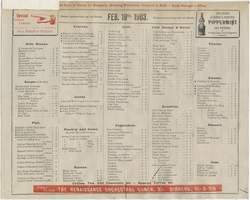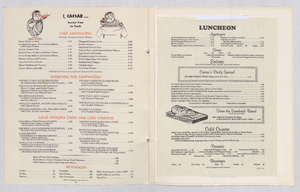Search the Special Collections and Archives Portal
Search Results
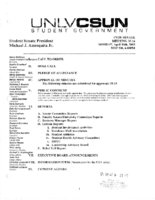
Meeting minutes for Consolidated Student Senate, University of Nevada, Las Vegas, April 18, 2005
Date
2005-04-18
Archival Collection
Description
Includes meeting agenda along with additional information about the budget impoundment act. CSUN Session 35 Meeting Minutes and Agendas.
Text
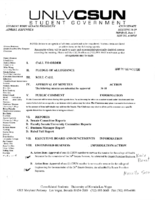
Meeting minutes for Consolidated Student Senate, University of Nevada, Las Vegas, June 05, 2006
Date
2006-06-05
Archival Collection
Description
Includes meeting agenda. CSUN Session 36 Meeting Minutes and Agendas.
Text
Audio recording clips of interview with Theron and Naomi Goynes by Claytee D. White, June 28, 2012, and July 12, 2012
Date
2012-06-28
2012-07-12
Archival Collection
Description
Two audio clips from an interview with Theron and Naomi Goynes by Claytee D. White on June 28 and July 12, 2012. In the clips, Theron and Naomi remember their early years in the Las Vegas schools and the advent of desegregation.
Sound
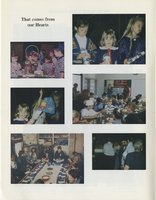
Member directory for Congregation Ner Tamid, 1990s
Date
1990 to 1999
Archival Collection
Description
The membership directory for Congregation Ner Tamid includes photographs of members and ongoing programs of the temple.
Text
Sondra Cosgrove (Vote Nevada) oral history interview conducted by Magalena Martinez and Elia Del Carmen Solano-Patricio: transcript
Date
2023-01-20
Archival Collection
Description
From the Lincy Institute "Perspectives from the COVID-19 Pandemic" Oral History Project (MS-01178) -- Community organization interviews file.
Text

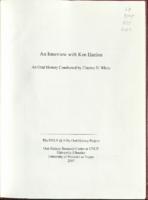
Transcript of interview with Ken Hanlon by Claytee D. White, November 29, 2006
Date
2006-11-29
Archival Collection
Description
Ken Hanlon was born in Baltimore, Maryland, in 1941. He attended 2nd grade through high school in Parkville schools. He took up his first instrument, the snare drum, at the age often, and by eighth grade had taken up baritone horn and trombone. His parents were very supportive of his interests. Ken developed a very strong work ethic early on, through the influence and example of his parents. He earned money in high school to pay for things he wanted by assisting on a paper route. He also took private lessons, which he paid for, and played in a dance band. After graduation, he attended Peabody Conservatory on a scholarship. He finished his last two years there with the principal of the Baltimore Symphony. He taught at Peabody Preparatory for seven years as undergraduate and graduate. He continued his Master's degree at Peabody Conservatory while working as a public school instrumental music teacher. He also played in the rock and roll band and worked in a city concert band. In 1968, Ken and his family moved to Las Vegas. He connected with the Si Zentner band and went on the road with him, then played in hotels up and down the Strip. Ken worked in bands that backed many famous headliners and has many anecdotes and memorable stories to share about those days. In 1970, Ken interviewed with Howard Chase, chair of the music department at UNLV. He was hired and his first UNLV job at the age of 29 was chair of the music department. He kept this position for 16 years, with one year off to establish residency for his doctorate. Dr. Hanlon has had a long and varied career, filled with people, places and events vital to the music industry. Today he continues to teach a graduate course, is currently Las Vegas president of the International Trombone Association, and runs the Arnold Shaw Popular Music Research Center.
Text
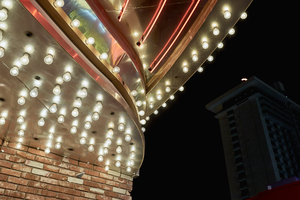
Photographs of Las Vegas Club signs, Las Vegas (Nev.), June 24, 2016
Date
2016-06-24 to 2017-09-02
Archival Collection
Description
The permanently closed Las Vegas Club Casino sits at 18 Fremont Street at the Fremont Street Experience. Information about the sign is available in the Southern Nevada Neon Survery Data Sheet.
Site name: Las Vegas Club (Las Vegas, Nev.)
Site address: 18 Fremont St
Sign owner: Las Vegas Club
Sign details: The Las Vegas Club originally opened on the opposite side of Fremont than it is today in the 1930's. It held one of the first few Neon signs on Fremont which was installed around ca.1930. In 1949 the Las Vegas Club reopened in its new location on Main and Fremont Street, and once held a large Baseball Hall of Fame. It has closed down in 2015 and demolition of the building began in 2017.
Sign condition: 4- Signage was working well and still had bright paint before the building had undergone demolition
Sign form: Pylon and architectural
Sign-specific description: They convey sports themes throughout their signs. There was a bronze-type sculptural baseball player. Large Neon and incandescent sign that wrapped around the whole building. Though above each entrance there is a plain graphic lettering with neon surrounding the letters.
Sign - type of display: Neon and Incandescent
Sign - media: Steel and bronze-type material (baseball player)
Sign - non-neon treatments: Sculptural element and incandescent
Sign animation: Flasher for incandescent
Sign environment: This location is on the north corner of Main and Fremont St. It is just north of the Golden Gate and across the street from the Plaza. It also had the Golden Goose, Glitter Gulch and Mermaids to the East of it.
Sign manufacturer: YESCO
Sign designer: Brian "Buzz" Lemming
Sign - date of installation: Circa 1960's
Sign - thematic influences: They convey sports/baseball themes within their signage which showcases the theme of their Baseball Hall of Fame.
Survey - research locations: Neon Museum Tour Hand book, Vintage Vegas http://vintagelasvegas.com/search/Las+Vegas+Club Images, Charles Barnard The Magic Sign.
Survey - research notes: The original Las Vegas Club in the 1930's had the tallest tallest sign in downtown Las Vegas until it was superseded by the Lucky Casino sign about a decade later.
Surveyor: Wyatt Currie-Diamond
Survey - date completed: 2017-09-02
Sign keywords: Architectural; Steel; Sculptural; Incandescent; Flashing; Neon; Bullnose
Site name: Las Vegas Club (Las Vegas, Nev.)
Site address: 18 Fremont St
Sign owner: Las Vegas Club
Sign details: The Las Vegas Club originally opened on the opposite side of Fremont than it is today in the 1930's. It held one of the first few Neon signs on Fremont which was installed around ca.1930. In 1949 the Las Vegas Club reopened in its new location on Main and Fremont Street, and once held a large Baseball Hall of Fame. It has closed down in 2015 and demolition of the building began in 2017.
Sign condition: 4- Signage was working well and still had bright paint before the building had undergone demolition
Sign form: Pylon and architectural
Sign-specific description: They convey sports themes throughout their signs. There was a bronze-type sculptural baseball player. Large Neon and incandescent sign that wrapped around the whole building. Though above each entrance there is a plain graphic lettering with neon surrounding the letters.
Sign - type of display: Neon and Incandescent
Sign - media: Steel and bronze-type material (baseball player)
Sign - non-neon treatments: Sculptural element and incandescent
Sign animation: Flasher for incandescent
Sign environment: This location is on the north corner of Main and Fremont St. It is just north of the Golden Gate and across the street from the Plaza. It also had the Golden Goose, Glitter Gulch and Mermaids to the East of it.
Sign manufacturer: YESCO
Sign designer: Brian "Buzz" Lemming
Sign - date of installation: Circa 1960's
Sign - thematic influences: They convey sports/baseball themes within their signage which showcases the theme of their Baseball Hall of Fame.
Survey - research locations: Neon Museum Tour Hand book, Vintage Vegas http://vintagelasvegas.com/search/Las+Vegas+Club Images, Charles Barnard The Magic Sign.
Survey - research notes: The original Las Vegas Club in the 1930's had the tallest tallest sign in downtown Las Vegas until it was superseded by the Lucky Casino sign about a decade later.
Surveyor: Wyatt Currie-Diamond
Survey - date completed: 2017-09-02
Sign keywords: Architectural; Steel; Sculptural; Incandescent; Flashing; Neon; Bullnose
Mixed Content
Pagination
Refine my results
Content Type
Creator or Contributor
Subject
Archival Collection
Digital Project
Resource Type
Year
Material Type
Place
Language
Records Classification

